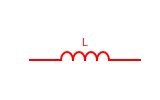Electrical components like resistors, capacitors, inductors and their combination offer an electrical impedance to the current flow. Ohm’s law gives an expression for the impedance (resistance) of a resistor in terms of current and voltage. But how to find the impedance of an inductor? In this article, I will explore the formula for the impedance of an inductor and its calculation by solving numerical problems on it.

By the way, do you know what is an inductor? The inductor is a circuit component just like a resistor, capacitor, etc that offers opposition to the change in current through it. This opposition is known as the impedance of the inductive coil. The symbol of the inductor is L. More precisely, the effect of the inductor is the inductance which has the symbol L.
Other names of the Impedance of inductor:
- Inductance
- Inductive reactance
- Resistance of inductor
What is the impedance of an inductor?
The electrical impedance of an inductor gives the measurement of the opposition to the change in electric current through the inductor coil. The most common name for the impedance of an inductor is inductive reactance. Conceptually, electrical inductance is very much similar to electric resistance. Sometimes, inductance is called the resistance of inductor. But there are some differences in properties and uses.
The unit of the inductance is Henry (H), but the unit of the impedance is Ohm.
Formula for impedance of an Inductor
If an alternating voltage of angular frequency \small \mathbf{\omega } is applied across an inductor of inductance L, then the reactance or the impedance offered by the inductor to the alternating current through it is, \small {\color{Blue} Z_{L}= j\omega L}………(1)
Here, j is the imaginary unit (\small j=\sqrt{-1}).
And, the magnitude of the impedance of the inductor is, \small {\color{Blue} Z_{L}= \omega L}………..(2)
This is the formula of inductive reactance or inductive impedance of a coil. Sometimes, it is called the inductor equation.
What is the impedance offered by inductor to the flow of DC?
In the equation of inductive reactance or impedance, one can see that the impedance is directly proportional to the angular frequency of the current flow through the coil. Now, a direct current (DC) has zero angular frequency.
Inductors will offer opposition to a change in current flow. But, the direct current never changes its magnitude and direction. Therefore, the inductor will not offer any impedance to the DC.
How do you calculate the impedance of inductor?
Now, we are to calculate inductance and inductive reactance by using the inductor equation \small {\color{Blue} Z_{L}= \omega L}.
1. An 3 mH inductor coil is operating on 50 Hz alternating current. Find the inductive impedance of the coil.
Answer: Inductance of the inductor, L = 3 mH = 3×10-3 Hz, Linear frequency, f = 50 Hz. Then angular frequency, \small \omega = 2\pi f = 314 rad/s.
Thus, the impedance of the inductor is, ZL = wL = 314×3×10-3 ohm = 0.942 Ohm
2. Find the inductive reactance of 25 mH inductor at 50 Hz.
Answer: Here, the frequency is f = 50 Hz. Then angular frequency, w = 314 rad/s (similar to the above problem)
Inductance of the inductor, L = 25 mH = 25×10-3 H,
Therefore, the impedance or the inductive reactance is, ZL = wL = 314×25×10-3 = 7.85 Ohm
This is all from this article on the Formula of Impedance of an Inductor. If you have any doubt on this topic you can ask me in the comment section.
Thank you!
Related posts:
- Electrical impedance
- Formula of Voltage drop across Inductor
- Faraday’s law of electromagnetic induction
3 thoughts on “Impedance of Inductor formula | Inductive reactance”
Comments are closed.